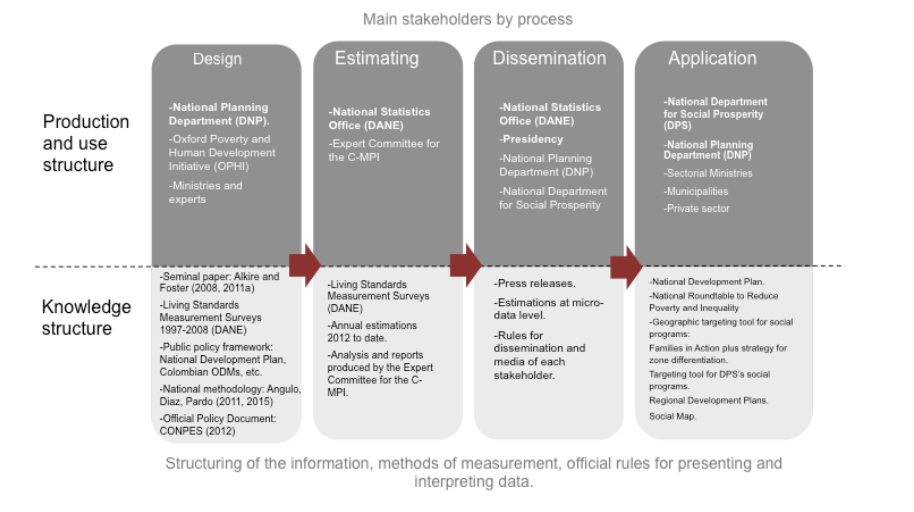
Search
Multidimensional poverty measurement in Colombia. What lessons can we learn?

The design of a multidimensional poverty index involves at least three issues of analysis and discussion: the conceptual issue considers the correct application of the method; the public policy issue must ensure the index reflects political priorities; and the statistical issue estimates the index and guarantees its robustness. The result will always involve trade–offs between conceptual concerns, public policies and statistics, and the proper definition of the objective and principal guidelines of measurement will be key for decision-making during the design process and implementation.
If the objective of the multidimensional index is to encourage action, then it will not only require a multidimensional design, it will be also necessary to design a solid institutional architecture that supports and legitimizes the process from the index design to implementation.
MPI – Colombia
On September 2011, after more than four years of technical discussions, the Colombian government launched new methodologies of monetary and multidimensional poverty measurement. With the advice of the Oxford Poverty and Human Development Initiative (OPHI), the multidimensional poverty index of Colombia (MPI-C) was introduced by the government as an innovation to complement the measurement of monetary poverty.
The sum of a multidimensional and strong design and a solid institutional architecture contributes to the stimulation of the multidimensional measurement in the coordination of a cross-sectional public policy to fight against poverty
Therefore, the MPI-C was designed at the same time as the National Plan of Development 2010-2014 by the National Department of Planning (DNP). Both methodologies were presented as part of the strategy of a monitoring platform for the reduction of poverty in Colombia for that period.
The case of Colombia has interesting shades. To start, it is the State as a whole that designs, applies and in general manages the MPI-C. Rather than a single institution in charge of all the design and application phases of the index, there are several government institutions involved in its development that are coordinated and have defined responsibilities. The institutional architecture used in that country considers specialities of government agencies in each part of the process: coordination is the responsibility of the National Department of Planning (DNP for its acronym in Spanish), which performs the design and the implementation of the index according to the monitoring function policies; the National Statistics Department (DANE for its acronym in Spanish), as an official autonomous agency, is concerned with statistics measurement and the implementation function focus on public policies design is the responsibility of the Department of Social Prosperity (DPS for its acronym in Spanish). This last institution formulates and runs social programs with a poverty reduction focus.
That is to say, the responsibilities on the design, estimation, dissemination and implementation of MPI-C are clearly defined (see figure 1). It should be noted that while there are institutions mentioned adobe, the implementation process considers a wide range of actors: ministries, institutions, local governments and private sector.
Figure 1. Institutional architecture for the multidimensional poverty index in Colombia

Moreover, a structured interaction between stakeholders and technical considerations exists. In Colombia, strategic actors “protect” measurement from the natural pressure of interested parties. As an example, the design process considers the advice and technical validation of the index carried out by OPHI. Furthermore, the estimation process involves a committee of experts (mostly independent) to guarantee transparency and technical quality.
In addition, in Colombia the process of implementation combines the MPI-C with other indicators and tools. The follow-up process at a national level involves not only MPI-C, but also considers monetary poverty, the Gini coefficient and the administrative objectives. As a focalization tool, the MPI-C has been used as a geographic approach that is usually combined with other variables depending on the area and objective of the social program.
Finally, from a conceptual point of view, the multidimensional poverty index represents the notion of multiple deprivations that individuals and households simultaneously faced.
As a consequence, a public policy solution requires the coordination of different sectors to eliminate different types of shortcomings simultaneously. In Colombia, this takes place at the National Roundtable to Reduce Poverty and Inequality, a high-level biannual committee convened and headed by the President of the Republic, where follow–up of government actions takes place. In the committee, participants are ministers that are directly related with the poverty reduction strategy and directors of institutions in charge of social programs. In the committee, the Board of Poverty and Inequality review takes place with four strategic indexes: monetary poverty, the Gini coefficient, the MPI-C, and the number of families that moved above the poverty line through the protection network for extreme poverty called “Red Unidos“.
The case of Colombia provides important lessons about good articulation between conceptual framework, statistics execution and implementation. The sum of a multidimensional and strong design and a solid institutional architecture contributes to the stimulation of the multidimensional measurement in the coordination of a cross-sectional public policy to fight against poverty.
*This article is based on the OPHI Working Paper 102 “From Multidimensional Poverty Measurement to Multisector Public Policy for Poverty Reduction: Lessons from the Colombian Case“, Roberto Angulo.
** Translated to English by Anna Valdés from United Nations Volunteers and Corinne Mitchell from OPHI.
Foto: David Álvarez Veloso
















